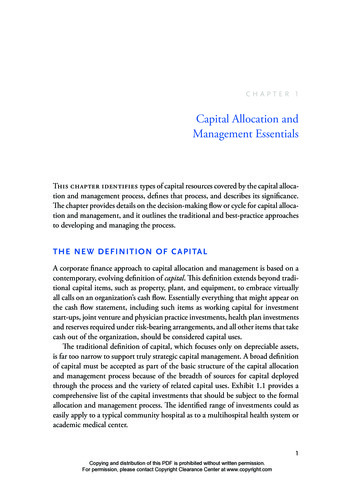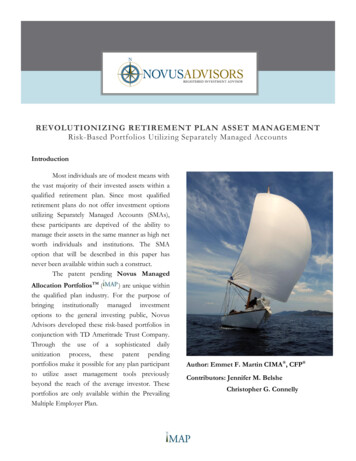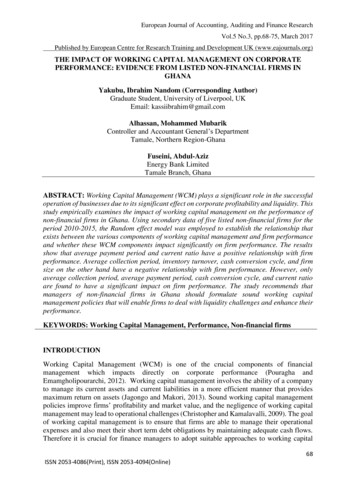
Transcription
CHAPTER 1Capital Allocation andManagement EssentialsThis chapter identifies types of capital resources covered by the capital allocation and management process, defines that process, and describes its significance.The chapter provides details on the decision-making flow or cycle for capital allocation and management, and it outlines the traditional and best-practice approachesto developing and managing the process.THE NEW D EF IN ITION OF C A P I TA LA corporate finance approach to capital allocation and management is based on acontemporary, evolving definition of capital. This definition extends beyond traditional capital items, such as property, plant, and equipment, to embrace virtuallyall calls on an organization’s cash flow. Essentially everything that might appear onthe cash flow statement, including such items as working capital for investmentstart-ups, joint venture and physician practice investments, health plan investmentsand reserves required under risk-bearing arrangements, and all other items that takecash out of the organization, should be considered capital uses.The traditional definition of capital, which focuses only on depreciable assets,is far too narrow to support truly strategic capital management. A broad definitionof capital must be accepted as part of the basic structure of the capital allocationand management process because of the breadth of sources for capital deployedthrough the process and the variety of related capital uses. Exhibit 1.1 provides acomprehensive list of the capital investments that should be subject to the formalallocation and management process. The identified range of investments could aseasily apply to a typical community hospital as to a multihospital health system oracademic medical center.1Copying and distribution of this PDF is prohibited without written permission.For permission, please contact Copyright Clearance Center at www.copyright.com
Exhibit 1.1 Investments Covered by the Capital Allocation andManagement Process Facilities, property, and equipment, including information technologyBusiness acquisitions and partnershipsDivestitures and asset monetizationEquity investmentsNetwork developmentManaged care investmentsNew operating entities, programs, and servicesProgram start-up subsidies or expansionPhysician integration, recruitment, practice purchase, partnership, and otherarrangementsOrganization-level (or system) initiativesNontraditional investments, such as post-acute care servicesSource: Kaufman, Hall & Associates, LLC. Used with permission.Applying this broadened definition of capital investments that should be subjectto the allocation and capital management process is critical as organizations focusstrategic investment away from capacity and toward efficiency and appropriate levels of care. In addition, as discussed in chapter 3, the definition of capital must holdtrue regardless of the anticipated source of funding for that investment (includingleases and philanthropy).In not-for-profit organizations, capital resources apportioned through the comprehensive capital allocation and management process come from three sources:cash flow from operations, philanthropy, and external debt. Chapter 3 describesthese resources in detail.CAP ITA L ALL OCATION AND M A NA G E M E NT D E F I NE DCapital allocation is the strategic process organizations use to make capital investment decisions. Through this process, healthcare executives determine how muchcapital will be spent and where the organization’s scarce capital resources, includingcash and debt capacity, will be deployed.A best-practice capital allocation and management process ensures that the organization spends the optimal amount of capital—not too much and not too little.2Strategic Allocation and Management of Capital in HealthcareCopying and distribution of this PDF is prohibited without written permission.For permission, please contact Copyright Clearance Center at www.copyright.com
It also ensures that investment is made in a portfolio of initiatives that provides apositive contribution to the organization’s strategic and financial positions.The capital allocation and management process is not capital budgeting. Exhibit1.2 describes how the capital budgeting process differs in content and context fromthe capital allocation and management process.In contrast to capital budgeting, the capital allocation and management processis comprehensive, with a broad purview over all calls on an organization’s cash(listed in exhibit 1.1). The success of the capital allocation and management processis directly tied to the organization’s strategic and financial performance. Availabledollars are identified on the basis of the organization’s long-term strategic andfinancial vision. Approved allocations of capital are expected to create an overallportfolio that will generate an optimal return over a multiyear period.Capital allocation and management comprehensively considers the short-termand long-term implications of each potential investment within an overall portfolioof investments. Its focus often extends over three to five years and even beyond—inthe case of facility development or the development of new programs, services, oraffiliations, for example. The detailed analysis (i.e., business plan) supporting eachcapital investment proposal provides transparency that enables executives to identify and track key accountabilities, opportunities, risks, and alternative outcomes.A well-devised business plan anticipates potential problems related to individualproject or portfolio performance. Problems that do occur can be corrected as theyarise, or, in the worst case, exit strategies previously defined in the business plancan be implemented before strategic and financial performance is materially andnegatively affected.Exhibit 1.2 How Capital Budgeting Differs from Capital AllocationCapital budgeting is the administrative process organizations use to identify andspend “routine” capital that has been allocated. It represents a small piece of thecomprehensive capital allocation and management process, typically relating onlyto minor expenditures that fall under department managers’ purview. Larger, morecomplex capital projects (often designated as “strategic”) tend to be reviewed andapproved outside the standard capital budgeting process in a planning processmanaged by a separate set of management players. Capital budgeting has a one-yearfocus. It is an administratively driven process whose success is measured by suchcriteria as “time required for completion” and “variance of expenses from budget.”Source: Kaufman, Hall & Associates, LLC. Used with permission.Chapter 1: Capital Allocation and Management EssentialsCopying and distribution of this PDF is prohibited without written permission.For permission, please contact Copyright Clearance Center at www.copyright.com3
THE SIGN IF ICAN CE OF C A P I TA L A L L O C AT I O N A NDMANAGEM EN TThe most important financial decisions made each year by an organization’s seniormanagement and ratified by its board relate to how much capital to invest and onwhich projects and initiatives those dollars will be spent. The long-term success of ahealthcare organization depends on the capital investment decisions it makes today.Every decision either increases or decreases organizational value. Investments thatprotect or improve the organization’s net cash flow stream by supporting successfulstrategies must be part of the long-term strategic and financial plan.Organizations cannot shrink their way to success. Leadership must act onthe knowledge that investments to create ongoing growth are the foundation forthe organization’s future. Decisions to invest capital must increase organizationalvalue—the organization’s ability to generate capital for future investment in knownor yet-to-be-defined strategies, maintain or improve its creditworthiness, andaccomplish its mission. For every investment that does not generate value (e.g.,mission- or community-directed projects), the organization must seek other waysto create equivalent cash flow and value to develop a balanced portfolio. The cumulative effect of incremental decisions determines the organization’s overall success.Exhibit 1.3 describes the new view of requirements to achieve growth and scaleunder healthcare’s transforming business model.High-performing organizations place a high priority on the formal allocationof capital because they understand that existing capital capacity, defined as theamount of debt- and cash flow–based capital an organization can generate andsupport, is a function of past performance. The creation and regeneration of capital capacity depend on the organization’s continuing ability to make value-addinginvestment decisions.New sources of cash flow are increasingly hard to find. In an environment ofconstrained payment, scarce resources, and increased competition, the cost of making bad capital investment decisions can be severe. Uninformed or poorly analyzeddecisions can have financial and market effects that emerge only three, five, or eventen years later. Such decisions reduce the organization’s capital capacity, limitingits ability to pursue future initiatives, and in turn, reducing its ability to achieve ormaintain competitive market strength.The safety net provided in the past by Medicare and Medicaid cost reimbursement and generous indemnity insurance structures no longer exists. Credit marketrequirements have tightened, demand for new business model investments hasincreased, and healthcare’s operating cash flow and access to affordable capitalare constantly challenged. To survive and succeed in the current environment,4Strategic Allocation and Management of Capital in HealthcareCopying and distribution of this PDF is prohibited without written permission.For permission, please contact Copyright Clearance Center at www.copyright.com
Exhibit 1.3 The New View of Growth Under a Value-Based Business ModelUnder the fee-for-service business model, volume for hospitals and health systemsis defined by the number of discrete services provided to patients. Providing moreservices yields more revenue for hospitals and health systems because insurersreimburse for each service delivered to insured patients. In a fee-for-service model,growth strategies typically focus on investment in new facilities that would increaseservice volume through added capacity.Under a value-based business model focused on managing population health,organizational growth will be achieved by increasing the number of individualscovered under risk- or value-based contracting arrangements and by covering thoseindividuals cost-effectively on a fixed-revenue-per-covered-life basis. Care may beprovided by the organization itself or by a provider in the network managed by theorganization.As healthcare’s focus transforms, the goal of an organization also must changeto a focus on building market share through its covered population, where theorganization must manage operating performance variability under risk-basedpayment models. Growth strategies under the new business model are moving awayfrom creating capacity to including investment in the right mix of providers, services,and delivery locations that support the right cost of care. The organization’s goal isto position itself to remain highly relevant to employers, insurers, and consumers.Business acquisitions, partnerships, and recruiting and investing in physicians arecommon growth strategies for building such market essentiality.Source: Kaufman, Hall & Associates, LLC. Used with permission.an organization’s capital allocation and management process must be based onprinciples of corporate finance, including the rigorous and consistent applicationof solid decision-making criteria, proven quantitative techniques, and enhancedtransparency.THE CAPITAL M AN AGEM ENT C Y C L EThe capital allocation and management process is an integral component of thecapital management cycle—an organic, circular pathway that defines the flow ofanalysis and decision making related to the management of capital, as shownin exhibit 1.4. A best-practice capital allocation and management process is thelinchpin in an organization’s ability to capitalize the strategies that it has defined,quantified, and made operational through the capital management cycle. Thesestrategies, which may be both market based and clinically based and both internaland external, include the following:Chapter 1: Capital Allocation and Management EssentialsCopying and distribution of this PDF is prohibited without written permission.For permission, please contact Copyright Clearance Center at www.copyright.com5
Support for the organization’s mission- and community-based imperativesStrategic investment in existing service line growth or new businesses andventuresOngoing infrastructure investment in the organization’s property, plant, andequipmentMajor and long-term investments, such as partnerships and new outpatient,virtual, or other access enhancementsMaintenance or growth of balance-sheet cash reserves to fund liquidity levelsconsistent with optimal access to capitalExhibit 1.4 The Capital Management CycleCan the strategies beimplemented in anacceptable credit context?Mission-BasedMarket StrategiesFinancial PlanningAnnual Budget Balance financial abilities withstrategy over five years Build cash and debt capacity Maintain single credit profileHow much debt?Under what structure?At what cost?Under what terms?Capital Allocation Support strategicimplementation in singlecredit profile Optimize flexibility and costCompletely integrated withstrategic plan, financial plan,and capital budgetFeedback andControlAccountability,credibility, andresults are keyCapital Management Take system-based approach Apply quantitative rigor Monitor resultsHow much can and should we be spending?Where are the capital dollars best deployed?Source: Kaufman,Hall & Associates,LLC. UsedLLC.withUsedpermission.Source: Kaufman,Hall & Associates,with permission.6Strategic Allocation and Management of Capital in HealthcareCopying and distribution of this PDF is prohibited without written permission.For permission, please contact Copyright Clearance Center at www.copyright.com
Embodying the key concepts of a corporate finance–based management philosophy, the capital management cycle starts with the identification, through thestrategic planning process, of market- and mission-based strategies that require funding. These strategies define the nature of the organization and the initiatives it wantsand needs to pursue in the next five to ten years to achieve its objectives.In the next cycle stage, the financial planning process, the organization quantifies the broad capital requirements and potential effects of the defined strategies.The goal of financial planning is to evaluate whether the identified strategies canbe implemented within an acceptable credit context. In conjunction with thefinancial plan, capital structure management focuses on optimizing the use of external sources (e.g., debt and philanthropy, where available) to fund the identifiedstrategies in a manner that ensures maximum flexibility and the lowest possiblecost of capital.The prioritization of specific capital investment opportunities is an iterativestep in the capital management cycle that occurs through an organization’s capitalallocation process. Capital allocation balances strategic opportunities with financialcapabilities. It ensures that capital is deployed to meet the organization’s strategicimperatives while enhancing the organization’s financial integrity through its portfolio, as described earlier.The annual budgeting process, which creates a current-year implementation andoperating plan, integrates the targets of the strategic and financial plans with thespecific investment decisions of the capital allocation process. The annual operatingbudget should be a strategic document that reflects the operating plan for an organization’s base business and implementation of selected strategies. It also providesa means to monitor revenue, expenses, and capital on an ongoing basis.Capital allocation is thus integrally linked with the organization’s strategic,financial, and capital planning processes, as well as its annual budgeting process.The key principle underlying a successful capital management cycle is as follows:Financial performance must be sufficient to meet the cash flow requirements of thestrategic plan and, at the same time, maintain or improve the financial integrity ofthe organization in a carefully evaluated credit and risk context. (Kaufman 2006)Healthcare executives of not-for-profit organizations vary in their awareness andapplication of this core principle. Executives who fail to see the interconnectedness of strategy, financial planning, and capital allocation are at significant riskof damaging their organizations’ financial performance and continued financialintegrity.Chapter 1: Capital Allocation and Management EssentialsCopying and distribution of this PDF is prohibited without written permission.For permission, please contact Copyright Clearance Center at www.copyright.com7
TRADITION AL AN D EM ER G I NG , Y E T P R O B L E M AT I C ,AP P ROACH ES TO ALL OCAT I NG C A P I TA LApproaches to allocating capital vary considerably in contemporary healthcareorganizations. A brief look at some common and emerging approaches that are notbest practice nor recommended can be instructive.First Come, First Served and Political ApproachesPerhaps the most prevalent approach to allocating capital in healthcare is the firstcome, first served approach. In hospitals and health systems that use this approach,specific projects are evaluated in a serial fashion as they arise throughout the calendar year.Organizations that employ this approach often go to great lengths to calculatethe total amount of cash flow available to be spent on capital, which is clearly a bestpractice concept. However, as the fiscal year progresses and projects are approvedone by one, capital is apportioned against the calculated limit. Inevitably, at somepoint during the year, a capital request to fund a project or projects capable of bringing significant growth to the organization works its way forward to be approved.Unfortunately, all of the capital may already have been spent, denying (or at best,deferring) funding for a key strategy. The serial nature of initiative evaluation andapproval precludes the ability to construct a portfolio of investments with the bestoverall strategic and financial return. Exhibit 1.5 illustrates how this occurs.A purely subjective or political approach also is problematic. The department,service, or other unit that demands the most gets the most. The trouble is thatsqueaky wheels with newly applied capital grease do not always bring the bestreturns. By essentially ignoring quantitative evaluation, this approach assumes thatthe core business can generate sufficient cash flow on an ongoing basis to supportinvestment initiatives that may not have acceptable returns. Often, this type ofprocess exists in organizations with highly centralized decision making and a culture that uses allocation of capital to reward past behavior or to appease a powerfulpolitical constituency.History-Based and Balanced Scorecard ApproachesAnother approach organizations often use is the history-based allocation approach,in which capital is allocated the same way it was allocated in the previous year. If a8Strategic Allocation and Management of Capital in HealthcareCopying and distribution of this PDF is prohibited without written permission.For permission, please contact Copyright Clearance Center at www.copyright.com
Exhibit 1.5 The Problem with First Come, First Served Capital AllocationSuppose that the leaders of an organization have 10 million to allocate to projectsduring a one-year period. Project A, costing 4 million, is proposed in February, looksgood, and is approved. Project B, costing 3 million, is proposed in March, looksacceptable, and is approved. Then Project C arrives in June. It has the best projectedreturn of all three projects and is associated with a key strategic initiative, but itcarries a 5 million price tag.Having already spent 7 million on Projects A and B, the organization simplydoes not have the funds for Project C. Management is faced with a devil’s alternative.Had all three projects been evaluated simultaneously, the leaders would havedecided to pursue Projects A and C and to hold off on B. Now the available optionsare to either forego a strategic opportunity or use precious cash reserves to overfund capital during the current fiscal year. This situation occurs simply because thebusiness plan for Project C took 60 days longer to prepare than did the plans forProjects A and B.Source: Kaufman, Hall & Associates, LLC. Used with permission.hospital’s radiology department or a hospital in a multihospital system received Xmillion or X percent of the total capital dollars this year, it would expect to receive thesame (and maybe even an increased number of dollars or a similar percentage) nextyear. The problem is that in today’s rapidly changing healthcare environment, pastperformance is not always the best predictor of future results, and the focus of pastinvestment may be inconsistent with the organization’s current strategic direction.Some healthcare organizations use a balanced scorecard approach, which may evaluate potential investments based on qualitative market and management issues, suchas community needs or physician satisfaction. For example, if a proposed project isdesigned to meet the qualitative goal of enhancing physician satisfaction, the balanced scorecard approach gives it high marks. Often, no quantification is provided.Corporate finance–based allocation of capital would force the analysis to go astep further and quantify the potential impact of increased satisfaction. Will greaterphysician satisfaction lead to more effective use of hospital services? If so, whatfinancial impact can be expected? Will ancillary service utilization change, and ifso, by what amount? Clearly, the answers to these questions often will be estimates,but even estimates provide the organization with some measure of the investment’spotential impact. Qualitative factors must be properly quantified and evaluatedwithin an overall context of performance.An additional problem with the balanced scorecard approach is its formulaic useof multiple, weighted criteria that essentially codifies the subjectivity of the groupresponsible for establishing the weightings. For example, if there are ten criteria,Chapter 1: Capital Allocation and Management EssentialsCopying and distribution of this PDF is prohibited without written permission.For permission, please contact Copyright Clearance Center at www.copyright.com9
it is possible that only 10 percent of the decision weighting would be assigned tofinancial return—one of the ten criteria. No organization can survive in the longrun if it consistently pursues a series of investment decisions that are strategicallydriven to the detriment of the organization’s financial position. Financial returnmust be weighted more heavily than other criteria, and the portfolio of investmentsselected must bring a positive return.Rolling Capital ApproachSome organizations are considering or are using a rolling capital approach. Thisapproach attempts to adopt a method successfully used in operating budget management. It is based on the belief that application of regular updates to the organization’s operating forecast (e.g., monthly or quarterly) will enable the organizationto more nimbly and effectively adjust its capital spending levels and priorities. Inits purest form, the rolling capital approach should result in a capital spending planthat would continuously reflect changes in operating performance, new technologies, short-term market reactions, and management priorities.While this approach can create significant decision-making flexibility, it is notrecommended because of its failure to apply key corporate finance principles thatare the foundation of the recommended best-practice process, as described later inthis chapter and in chapter 2. These key principles include the following: 10Standardized decision making. A key component of the rolling capitalapproach is the aggregation of different types of capital projects into multipleportfolios. For example, project groups might include those focused onfinancial margins, organizational mission, maintenance, value, cost reduction,and others. Each of these groups is handled differently based on its uniquecharacteristics. This differential handling undermines the organization’s abilityto provide the standardized decision-making approach that has been shown tobe vital to a successful capital allocation process.Project return. The rolling capital approach applies different returnrequirements to different project groups based on their intent (e.g., valuecreation, cost reduction) rather than a common return requirement that isthen adjusted for potential risk (see chapter 6). The lack of a common returnrequirement creates significant opportunity for the process to be manipulatedthrough definition of project types or intent and alternative returnrequirements. This undermines the integrity of the decision-making process.Strategic Allocation and Management of Capital in HealthcareCopying and distribution of this PDF is prohibited without written permission.For permission, please contact Copyright Clearance Center at www.copyright.com
Portfolio return. A continuously changing capital spending plan essentiallycreates serial capital review and approval, which diminishes the organization’sability to understand the potential return on investment of the capitalinvestment portfolio.Corporate-based financing decisions. The lack of a firm capital portfoliodiminishes the ability of the chief financial officer (CFO) to make validfinancing decisions. If the portfolio changes, financing structure and costof capital are affected. A basic tenet of corporate finance is the separation ofproject and financing decisions. This concept reflects the need to optimizeaccess to capital by matching the organization’s approved capital requirementsto potential means of financing (i.e., debt versus equity). Furthermore, inthe realm of tax-exempt financing, debt must be associated with specific,appropriate capital initiatives with quantified useful lives. If an initiative isaltered to reflect a short-term change in priorities, the tax-exempt status ofdebt issued for the initiative could be materially affected.As other approaches to capital allocation and management are developed overtime, they also should be evaluated relative to current best practices. It is vital tounderstand whether proposed new approaches embody the key tenets of corporatefinance; reflect the reality of capital acquisition and financing in healthcare; andsupport consistent, standardized, and metrics-based decision making that createsaccountability and transparency.CH ARACTERISTICS OF A B E S T -P R A C T I C E P R O C E S SThe recommended approach to allocating capital in healthcare organizations shouldbe no different than that used by many Fortune 500 corporations. A best-practiceapproach has the following objectives: To support the mission and strategic goals of the organizationTo match capital availability to financial performanceTo protect or create capital capacityTo provide uniform criteria for project evaluationTo maximize transparency and, therefore, accountabilityTo maintain the highest possible bond rating (i.e., optimal access to capital)To ensure consistent investment in the highest-performing assetsChapter 1: Capital Allocation and Management EssentialsCopying and distribution of this PDF is prohibited without written permission.For permission, please contact Copyright Clearance Center at www.copyright.com11
Structurally, best-practice capital management is founded on the following keyelements: A high level of governance, education, and communicationA coordinated calendar and planning cycleDirect links to a sound strategic and financial planClear definitions of available capital and capital expendituresRigorous, quantified, and consistent business planning for each investmentopportunityA standardized, one-batch review of potential investmentsConsistent application of quantitative analysis using corporate finance–basedtechniquesData-driven and team-based decision makingRigorous postapproval project monitoring and measurementAll of these characteristics, which shape the contents of the rest of this book, areevident in leading US hospitals and health systems. In many other organizations,progress is being made and pieces of this best-practice process are in place, butthey are not yet fully integrated with the entire process or with the other components of the capital management cycle. In yet other organizations, the problematicapproaches described earlier result in varying degrees of dysfunction in the management of the organization’s capital process and the results it generates.An ongoing survey of capital management approaches employed by health systems of varying sizes and locations indicates that most systems have processes withsimilar characteristics, though with some variations as a result of organizationaland cultural characteristics (Sussman 2016). Rigor, discipline, transparency, andstandardization are present in all systems that consider their capital allocation andmanagement process to be successful.Common ChallengesThree significant challenges prevent comprehensive application of important principles and practices related to capital allocation and management:1. Overconfidence. Some exe
The capital allocation and management process is an integral component of the capital management cycle—an organic, circular pathway that defines the flow of analysis and decision making related to the management of capital, as shown in exhibit 1.4. A best-practice capital










